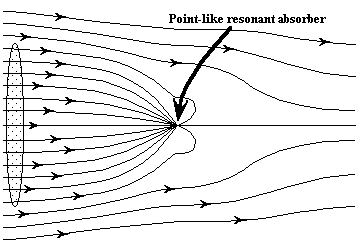C. F. Bohren, "How can a particle absorb more than the light incident
on it?", Am J Phys, 51 #4, pp323 Apr 1983
See 196 citations
ABSTRACT
A particle can indeed absorb more than the light incident on it. Metallic particles at ultraviolet frequencies are one class of such particles, and insulating particles at infrared frequencies are another. In the former, strong absorption is associated with excitation of surfaces plasmons; in the latter it is associated with excitation of surface phonons. In both instances, the target area a particle presents to incident light can be much greater than its geometrical cross- sectional area. This is strikingly evident from the field lines of the Poynting vector in the vicinity of a small sphere illuminated bya plane wave.
H. Paul and R. Fischer "Light Absorption by a dipole",
SOV. PHYS. USP.,
26(10) Oct. 1983 pp 923-926, also see
33 citations
ABSTRACT
In semiclassical radiation theory, the electric dipole moment induced on an atom by a strong incident field absorbs much more energy, per sec, than is flowing through its geometrical cross section. This means that the atom has the capability to "suck up" electromagnetic energy from a spatial region that is by far larger than its own volume. An intuitive understanding of this effect is provided by studying, in the framework of classical electrodynamics, the energy flow in the total field made up by superposition of the incident wave and the field that is generated by the dipole also in the absorptive case.

|
Fig. 1 Effective Aperture enhanced by resonance
Suggested by Winfield Hill:
ZB Wang "Energy flow around a small particle investigated by classical Mie theory" 2004 PRB V70, in Phys Rev B
S Papernov, "Correlations between embedded single gold nanoparticles in..." J App Phys V92 2002., in J. Applied Phys
Also suggested by A. Boswell, regarding small-antenna physics:
Chu, LJ Physical limitations of omni-directional antennas. J. Appl. Phys. 19, 1163.1175 (1948). RC Hansen, "Fundamental limitations in antennas," Proc.IEEE V69 No2 (1981.)